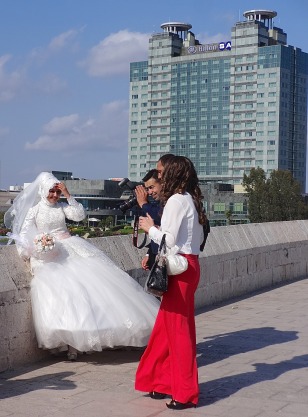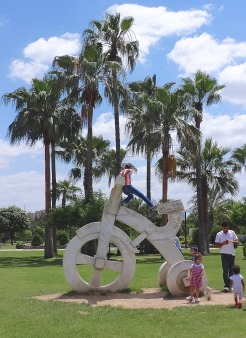Home to the Adana kebab Population: 1,836,000
Festival: Orange Blossom Carnival (late April)
Turkey’s sticky-hot fourth biggest city sits on the pancake-flat land around the delta of the Seyhan river. At first sight it offers little of interest to visitor. Linger for a bit, though, and you may find its mix of cultures and the juxtaposition of old and new increasingly appealing. It’s also useful as a base for exploring nearby sites with limited accommodation options.
Don’t come here expecting another go-getting, fast-modernising metropolis like Eskişehir or Ankara. Instead, Adana feels at times rather like the old Turkey, a place of broken pavements and general dismal grunginess. For whiz-bang get up and go, you need to head instead for neighbouring Mersin.
None of which is to say that Adana isn’t worth a few hours of anybody’s time, not least because it possesses, in the Sabancı Merkez Cami, one of the finest mosques to have been built in Turkey since the 19th century.
There has been a big influx of migrant workers into Adana from south-eastern Turkey – look out for the distinctive mauve headscarves worn by both men and women. More recently a new population of Syrian refugees has arrived to join them.
Central Adana is divided in two by the Turhan Cemal Beriker Bulvarı. North of this line Atatürk Caddesi and Ziyapaşa Bulvarı provide cool, calm, tree-lined streets – the Bağdat Caddesis of Adana, perhaps. South of the line expect an oriental chaos of uncontrolled traffic, pop-up pavement stalls and people, people, people.
Don’t leave town without:
- tucking into an Adana kebab, a long strip of mince spiced up with pepper and grilled on a skewer
- knocking back a glass of şalgam, a bitter turnip juice drink.
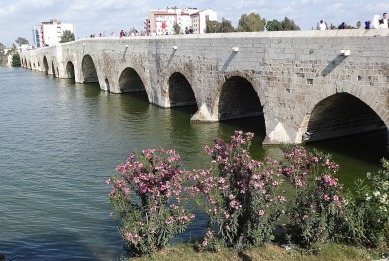 Around town
Around town
The older part of Adana is south of the centre and west of the Seyhan river.
A good starting point is the newly restored Roman Taşköprü (Stone Bridge) built in the reign of Hadrian c.125 and restored by Justinian in the sixth century.Today only 14 of the original 21 arches survive, but they make an impressive sight at least from a distance – sadly, as you walk across you will discover the crude tags disfiguring the walls. The bridge’s foundation stone survives in the museum.
Facing the bridge on the west side of the river are some fine Ottoman houses. The Suphi Paşa Konağı was visited by Atatürk on several occasions between 1923 and 1925 and is now a museum. Another houses Adana’s Cinema Museum with lots of memorabilia in particular about Yılmaz Güney, the famous director of Palme d’Or-winner, Yol (The Road).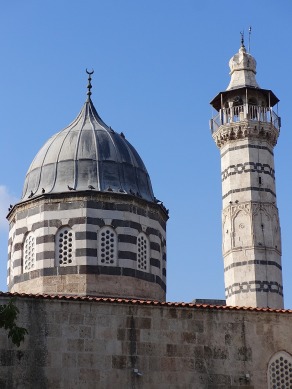
Head south and then cut in away from the river to find the Ulu Cami which dates back to 1541. It’s an extraordinary, lovely and very un-Turkish-looking mosque. Ramazanoğlu Halil Bey began work on it in 1513 and it was completed by his son, Piri Mehmeh Paşa. The mosque pulls together elements of Selçuk and Ottoman architecture with Mamluk twists and even the odd pinch of Romanesque to produce something without fellows in Turkey. The most striking external features are the beautifully carved minaret, and the black and white striped doorways which open onto the courtyard. Internally it’s the İznik tiles on the lower walls and the delightful stained-glass windows that prove most memorable.
Ramazanoğlu Halil Bey is buried in a tomb attached to the mosque which the caretaker will be happy to show you. High on the wall is a wooden cupboard containing a hair from the beard of the Prophet Mohammed which goes on display during Ramazan each year. When you leave the mosque make sure to glance upwards at the cute little dome covering the tomb.
The Ulu Cami still retains parts of its külliye (complex), including a tree-filled medrese (theological school) now used for conferences. Immediately behind it is a small park in which is buried the poet Ziya Paşa (1825-80) who was also a mayor of Adana.
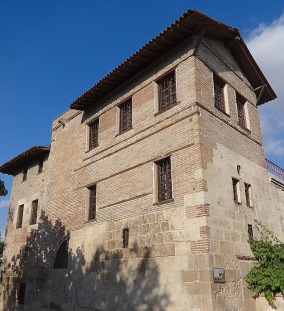 Facing the park is the lovely brick and stone Ramazanoğlu Konağı, the oldest house in Adana, which dates back to 1495 when it was part of the local palace. It is now owned by the local university and reminds me of the İbrahim Paşa Sarayı in İstanbul‘s Hippodrome, now home to the Museum of Turkish and Islamic Arts.
Facing the park is the lovely brick and stone Ramazanoğlu Konağı, the oldest house in Adana, which dates back to 1495 when it was part of the local palace. It is now owned by the local university and reminds me of the İbrahim Paşa Sarayı in İstanbul‘s Hippodrome, now home to the Museum of Turkish and Islamic Arts.
Cross the small park behind it to find the Great Clock Tower dating back to 1881. It acts as a marker for finding Adana’s bazaar quarter.
The crowded bazaar streets cater for the locals rather than tourists, and you may be surprised what you find on sale there. There are also many old-fashioned sweetshops here, including Tarihi Kazancılar Helvacısı Hacı Ahmet Şahin which has been in business since 1884 and where you can still watch tahini paste being churned out by the original machinery.
The market is a good place to tuck into a spicy Adana kebab at one of the simple restaurants serving local workers, or, if your tastes run to something more formal, at Tarihi Adana Kazancılar Kebapçısı which has been in business since 1908.
Here, too, you’ll find the Çarşı Hamamı (Market Baths) still in operation for both men and women, as well as the Yağ Cami (Oil Mosque) in the part of town where oil used to be sold. It was built onto the older Church of St John, recognisable from its apse. It was Ramazanoğlu Halil Bey who had the mosque built alongside it in 1501.
A second church dating back to Crusader times but completely rebuilt in the 19th century is off İnönü Caddesi. Newly restored, it houses the city’s ethnography museum (closed Mondays).
The most conspicuous modern monument in town is the Merkez Sabancı Cami in a splendid landscaped park beside the river. Work on the mosque started in 1988, long before industrialist Sakıp Sabancı took an interest in it. When the money ran out, he stepped in to keep the project going, and since he was at the time the wealthiest man in the country, Adana now has the largest mosque between here and Saudi Arabia, complete with six minarets, a distinction it shares with the Sultanahmet Cami (Blue Mosque) and the Çamlıca Cami in İstanbul.
In his travel book In Turkey I am Beautiful, writer Brendan Shenahan slammed the mosque as soulless, but it’s only soulless in the sense that all new buildings tend to be, because it lacks the romantic aura of history that clings to the stones of older buildings. For most people, however, this is a mosque which has the wow factor in spades. As soon as you cross the threshold you feel your jaw dropping as your eyes flicker over the stained glass, run around the blue and white tiles, and then sweep up to the soaring dome.
North of Turhan Cemal Beriker Bulvarı and along Ziyapaşa Bulvarı you’ll find the quieter, calmer and much more upscale district around leafy Atatürk Park. Come here to cruise the cafes, restaurants and boutiques, and to get a look at a rather different Adana than the one you see at first-sight one.
The huge Adana Archaeological Museum is housed in the old Simyonoğlu textile factory 4km west of the town centre in the Döşeme Mahallesi. It contains a stunning collection of finds from the surrounding area (especially from the archaeological sites of the Çukurova), including mosaics moved here from Anavarsa and Misis.
Eating
Of course the thing to do in Adana is to eat Adana kebab. One long-lived and popular place to do so is the Öz Asmaaltı restaurant near the Hotel Mercan which has been in business for more than 65 years. The upstairs terrace area looks down on the domes of the next door hamam and makes a great place to eat on a hot and sweaty evening. I also enjoyed a meal at Kebapçı Mallun, near the Tahtalı Cami. Probably best of all was the kebab served at Kebapçı Şeymus (Cemal Gürsel Caddesi), recommended to me by a foodie friend.
Sleeping
Unfortunately most of Adana’s places to stay are clumped together in the noisy and unattractive streets between the landmark mauve-and-blue Çetinkaya department store and the Beşocak Meydanı marked by a statue of Atatürk. There’s something here to suit all budgets, but it’s also worth considering the waterside hotels in Tepebağ or even the Hilton or Sheraton if you can afford the splurge.
Make sure your room has air-con – you’ll need it in summer. For more and cheaper choices head on to Mersin. The beach resort at Yumurtalik is another option. The one at Karataş is far scruffier.
Adana Hilton
Looming up beside the Taşköprü, this 308-room behemoth of a hotel has indoor and outdoor pools and a renowned restaurant to supplement its spacious suites, the best with views across the river to the Sabancı Cami.
Tel: 0322-355 5000, Haci Sabancı Bulvarı, www.adana.hilton.com
Sheraton Adana. Tel: 0322-237 1717
Transport info
Adana airport (ADA) is a major link to southern Turkey with plenty of daily flights. Unusually it’s within walking distance of the city centre.
Adana’s bus station is a major transport intersection with many buses to all the surrounding towns although there are only two or three direct buses daily through the Cilician Gates to Cappadocia; you may have to change buses in Niğde.
Buses to Mersin, Tarsus and Pozantı also leave from the main otogar. You can get to it by local bus from near the main Çarşı post office; find this by walking down Bankalar Caddesi (Bank Street) from behind the Kemeraltı Cami on the edge of the Beşocak Meydanı (the square with a statue of Atatürk in it).
Buses to nearby destinations on the eastern side of the city such as Kozan and Ceyhan leave from the Yüreğir (“Yur-ay-ear”) bus terminal on the eastern side of the river. Local buses to the terminal leave from near the main Çarşı post office.
Infrequent local buses link the two bus stations; you’re probably better off changing bus in front of the post office. The taxi fare between the two bus stations is steep.
The TCDD train station is at the northern end of Ziyapaşa Bulvarı in the more modern part of town. There are frequent train services to Mersin and Tarsus.
The Adana Metro doesn’t transit the town centre, making it of limited use to visitors. However, you can use it to get from Yüreğir bus station (Akıncılar station) to near the mainline train station (Vilayet station).
Day trip destinations
Alman Köprüsü (German Bridge, Karaisalı)
